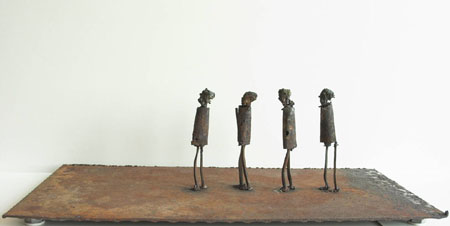|
Hobby-weldingfor creativity or home repair.SOLUTIONS with Effective, Powerful Advice
Hobby-welding, home welding processes, decorative gates, trellis, fences, home weld repairs, farm tools, small creative project welding, creativity. Welding techniques, welding information, welding links, welding tips, welding instructions, welding training, improving welding results, welding safety issues, joining questions needing answers. These are some of the items developed in this Site for the benefit of interested readers.
Visit the NEW Page on Welding Overview, for a thorough Introduction to Welding.
with active life of self expression!
Picture yourself repairing those stairs, gates, implements...
Hobby-welding is the subject of the following page where we are going to deal with important issues to be considered when preparing for non professional use of welding for repair of home items, for personal expression and for pleasure. Imagine that you build new objects, furniture, tables, lamps...
Hobby-welding at home can be a rewarding pastime for enthusiastic weekend welders. Hobby-welding can provide quite important returns if used for repair or for building of original fences, gates, implements, tools and nearly anything that is needed in and around the house. But mostly it returns satisfaction for accomplishments. Hobby-welding also lends itself to artistic exploitation for the talented individual who enjoys building objects of art of his/her own conception and realization. See yourself create that perfect aesthetic statue, the monument to your creative instincts, the expression of your personality...
Like any other handicraft, Hobby-welding must be learned and mastered. Unless you are already knowledgeable with the trade, but maybe even then, the best option would be to enroll in a good school program, to gain hands on experience and to get a feeling of what it is all about. This even before you select your tools and equipment. And you MUST learn the basics of Safety Practices, because of the many dangers around. Tip!: You could contact AWS, and search "learning track" or "training". Not only for saving, not merely for gain, but for fun and accomplishment, for gratification and fulfillment.
You should decide beforehand which processes you would like to practice, and for what materials, because it is not probable that you be exposed to all the major ones during a course of a few weeks at best.
First a good Hobby-welding course... The Hobby-welding courses give also a first hand approach to the importance of safe habits and to the correct way of using equipment and accessories. Those who bring welding inside their houses should always be aware of the dangers of playing with fire. In order to make up your mind you could visit welding shops and talk to experienced welders, explaining what you have in mind and asking them for their suggestions. Maybe you could arrange with them to work temporarily for your Hobby-welding on their equipment while not in use. Your know how will grow, with our help... and with your study.
Regarding process and equipment, we will propose our personal point of view, but it may be off the mark for you if your purpose is different. So take it just as a point of view. Tip!: We think that from the start one should select mild or low carbon plain steel for Hobby-welding as the material of choice, for a number of reasons. Which materials...? Mild steel is inexpensive, it is available, it can be obtained as sheet, bar, plate, tube, wire, profile, it is relatively easy to cut, saw, file, cold form and weld, it is easily deformable (forged) when heated, it is versatile. Useful stumps can be found in a junk-yard, but then you may need to inquire which material is it: click on Material Identification. The disadvantages are that any sizable object could turn out quite heavy, and that it tends to rust readily if left unprotected without painting. Your experience will improve and increase... with your constancy.
Unless of course you are devoting yourself to Hobby-welding of jewelry and precious metals. But in this case you should also consider BRAZING as an option, because it is performed at lower temperatures: we are going to deal briefly with this issue in other pages. Your results will be there, tangible proofs of achievements,
Stainless steel, aluminum and copper should be left out from Hobby-welding, at least to begin with, because learning to weld them is not straightforward. Although, if you feel attracted by these materials, you can definitely master what you need. But basic welding skills with mild steel will certainly help you. On this Site you will find all you may need for starting and for continuing.
What process...?
If you agree with the material selection you will be faced now with process and equipment choice. The least expensive equipment for Hobby-welding would probably be a single phase welding transformer for stick welding (SMAW - Shielded Metal Arc Welding).
You should have or procure welding gloves and personal protection accessories, helmet with protective dark glass (if you prefer it to the mask), apron, cap, boots and working clothes not included in the kit. Equipment...? It should be understood that a single phase welding transformer puts an unbalanced charge on the power grid of the house. And one should be aware of the duty cycle established by the manufacturer (that is the percentage of the working time the power supply can be on, out of the total time of ten minutes, to allow for cooling off). Tip!: For Hobby-welding small objects one would need a welding table and a few tools like a special welding hammer to remove the slag and a wire brush to clean the weld. A bench vice bolted to a working table and a power grinder, fixed or portable, may be handy. Consumables are: covered electrodes adapted to alternating current welding and the electric energy used. Space... For Hobby-welding, what is needed is a suitable uncluttered ventilated space far from combustible materials or structures. And an outlet of electric power of sufficient amperage for the heaviest electrode usable with the selected transformer. All of the above can be purchased within a quite modest budget. But before making a substantial outlay one could inquire if used and reconditioned equipment might be the less expensive solution: there is a market for used welders, and maybe you might get a bargain. If you prefer to test different outfits you can lease equipment for a short time and then change to something else until you are satisfied with your selection. Also pooling resources with friends might be an attractive solution.
Safety issues... ... are most important and must be addressed and taken care of by implementing needed precautions. For an overview of this subject click on SAFETY. Arc-welding, however, depending on the planned Hobby-welding job requirements, may or may not be the most suitable choice. Although with this process one can weld in all positions, even overhead, and this quality alone may well be the most important consideration, one need a good measure of dexterity and skill to succeed in welding thin thicknesses like those likely to be employed for Hobby-welding. New Page Please note that a new page on Jewelry Artwork was recently added to our Website. See how could you implement your ideas on this subject.
Our Recommended Process We would like to present the personal opinion that oxyacetylene welding (see Gas Welding Equipment) might be more suitable for welding of thin items, more often used for Home or Hobby applications, because the flame is easily regulated to the needed heat and a tiny molten drop can be deposited where you want. Equipment for oxyacetylene welding, both stationary and portable, includes cylinders and regulators, flexible rubber hoses and a torch with interchangeable tips, a scratch lighter, protective dark goggles. For home use substandard capacity cylinders are available, which are lighter than regular ones and easier to move, although somewhat more expensive to refill. No external energy source is needed, so that equipment and supplies are portable. The same equipment, with different consumables, makes possible to perform BRAZING, which may be useful for certain applications. For the above page click on Brazing. If you are looking for Oxy-Acetylene Equipment including Welding and Cutting-torch you may wish to consider the following suggestions.
Click on the items selected to reach the Product Description Page. Compare descriptions to make sure that the product meets your requirements.
Welding is possible as long as there are gases in the cylinders, that can be returned for refilling. Accessories like a stainless steel wire brush for removing rust, and pliers for moving hot parts should be available. Other items may be handy for use but perhaps not absolutely necessary. The place and the welding table should be adapted to the work one wishes to carry out. Safety issues are different but not more relaxed. Consumables, besides gases, are mild steel filler rods and fluxes, if needed. Brazing and Braze-welding are also possible with suitable filler materials and flixes. See Brazing and Braze Welding. Scope of applications for Home and Hobby work is extremely large depending upon the individual's initiative and fantasy. Although in theory it should be possible to oxyacetylene weld aluminum and stainless steel using a proper flux, we believe a better solution would be preferable. In order to deal successfully with aluminum and stainless steel, one should be ready to invest more in equipment for Gas Tungsten Arc-Welding (GTAW) (Also called Tig). The process is described in another page on Arc Welding. The consumables include also argon gas in a refillable cylinder and tungsten electrodes, besides welding rods compatible with the material to weld. Cooling water may also be needed except for the smallest torches which are air cooled. But before committing to such an expense, it is advised, if at all possible, to work for training in an established welding shop with a part time agreement, to test if this solution is really what is wanted for Hobby-welding. We are painfully aware of the fact that you may still have many questions left. We would urge you, for any questions on these subjects, to write us by e-mail. Click on Contact Us.
And yes, please be informed that we welcome your feedback, to make this Site more useful to you, and stuffed with more benefits. See our new page Welding Talk and use the form there for your comments. Any questions or comments or feedback? Write them down and send them to us by e-mail. Click on the Contact Us button in the NavBar at top left of every page.
Visit our Welding Art page and, if you enjoy welding art objects, send us a photo and a short story: they will be posted for all to see...
Your mind is probably bursting with ideas and projects. But if you need Inspiration or if you just want to see what other Artists have been doing using these same techniques, you are urged to have a look on Welding Art Books and Video
Bird by Uri Sharon
Contemporary Metal Sculptures
Let us offer you a FREE subscription to our Practical Welding Letter with items written for you at your request. To reach a Page, listing the most important Articles from Past Issues of Practical Welding Letter, click on Welding Topics. And get also a FREE book in pdf format to download to your computer on PRACTICAL HARDNESS TESTING MADE SIMPLE. Act now and you will enjoy receiving informative and useful tips and knowledge for your continuing education and progress. Please Subscribe! Understanding Hardness Testing will help you when Welding Unknown materials.
If you did not yet find what you need, why not typing your question in the following Search Box?
Click on SBI!: A New Day

POWERED BY: Click on this Logo NOW! Copyright (c) 2003-2008, 2009, 2010, 2011, 2012, 2013, 2014, 2015, 2016, 2017 Hobby-welding as a pastime or useful housework for building and repairing can provide deep satisfaction for accomplishments. It is worth a few tips, first on safety. See here... 
|





